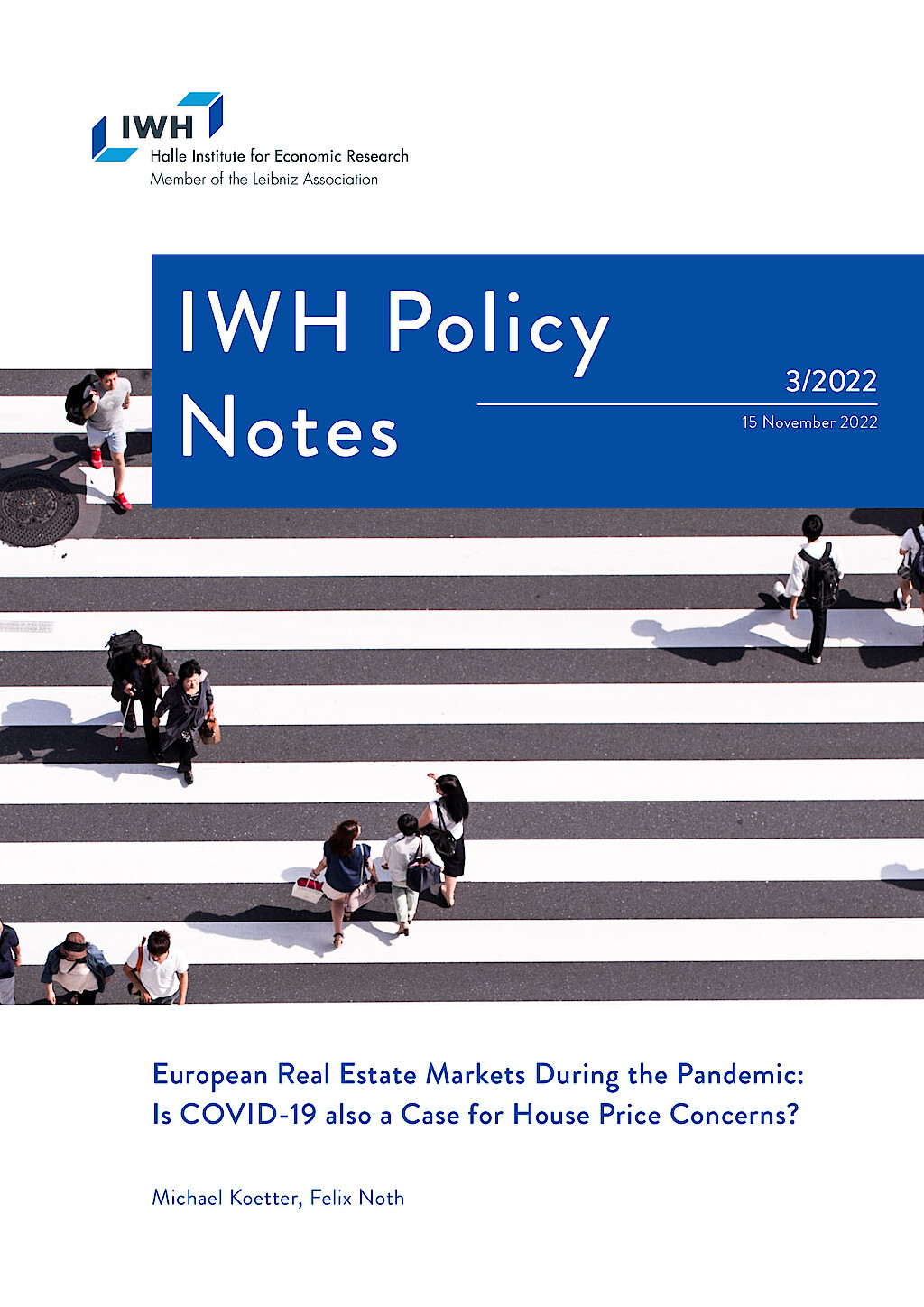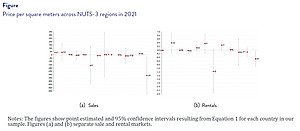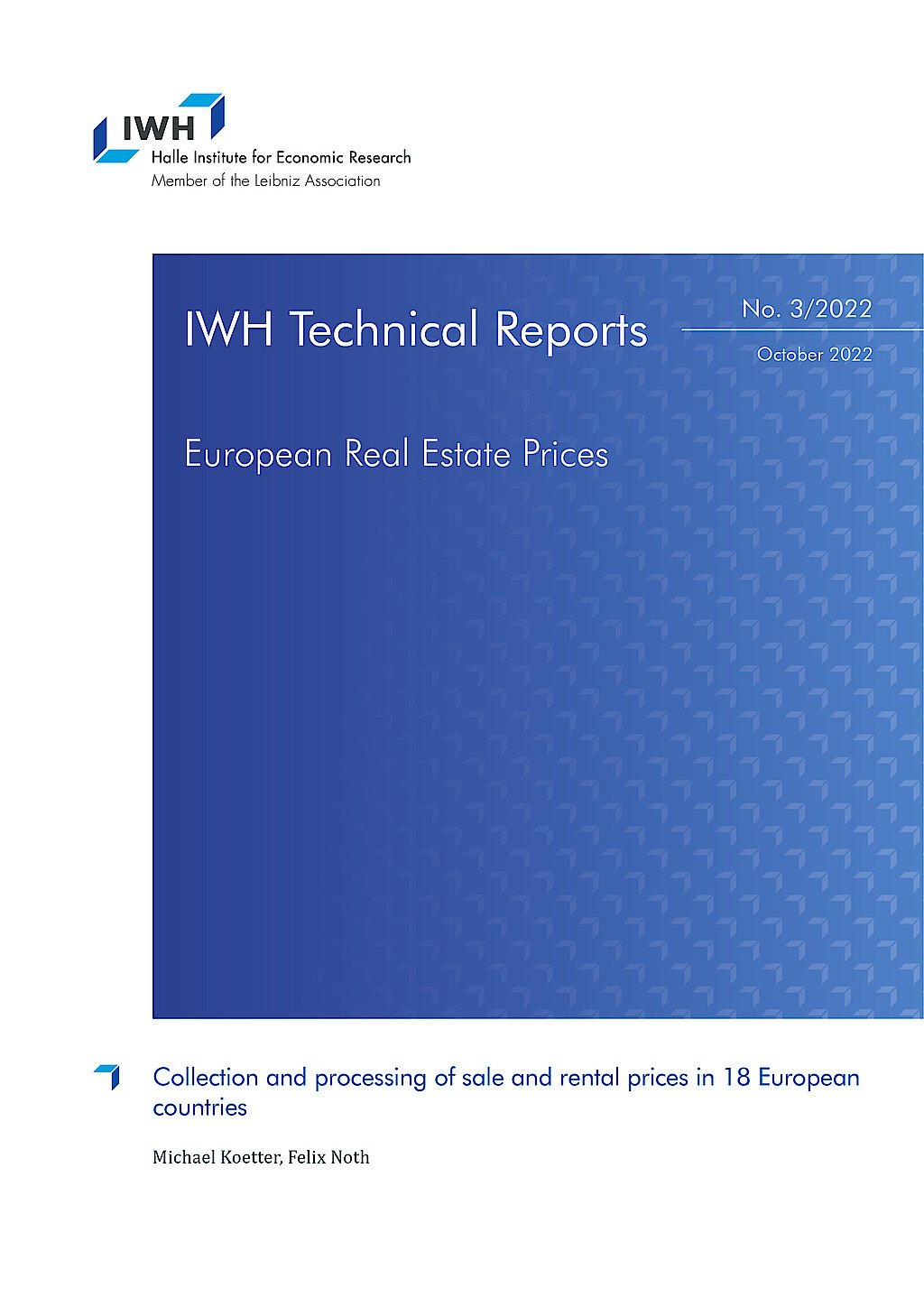
European Real Estate Markets During the Pandemic: Is COVID-19 also a Case for House Price Concerns?
We use a new database on European real estate purchase and rental prices – the IWH European Real Estate Index – to document the relationship between staggered COVID-19 dynamics and real estate prices in 14 EU countries between January 2020 and December 2021. For most countries, we find no statistically significant response of monthly purchase and rental prices due to an increase of regional COVID-19 cases. For the UK we find that more COVID-19 cases depressed both purchase and rental prices significantly, but the economic magnitude of effects was mild during this sample period. In contrast, rents in Italy increased in response to hiking COVID-19 cases, illustrating the importance to consider heterogeneous crisis patterns across the EU when designing policies. Overall, COVID-19 dynamics did not affect real estate values significantly during the pandemic, thereby mitigating potential financial stability concerns via a mortgage lending channel at the time.
30. November 2022
Motivation
With the outbreak of the COVID-19 pandemic in January 2020, the European Union (EU) faced massive economic stress. According to the IMF, GDP contracted in the first year of the pandemic by 6.1% and European member states, the European Union, as well as the European Central Bank took numerous measures early on to counteract these adverse economic effects. However, the timing and intensity of pandemic shocks, for example reflected by infections and casualties, differed vastly across EU regions. Likewise, policy responses exhibited a staggered enactment pattern across countries and varied by extent and duration.
In this note, we shed light on the question whether and to what extent the contagion dynamics of the COVID-19 pandemic affected EU housing markets. The relationship between pandemic patterns and real estate markets is important from an economics perspective for two main reasons. First, real estate represents the most important component of non-financial household wealth, which in turn is a determinant of private consumption. If, for example, aggregate demand contractions due to curfews and increased labor income uncertainty exerted downward pressure on real estate prices, deteriorating household wealth might have contributed to the recessionary tendencies documented by the IMF. At the same time, other factors during the pandemic might have counteracting effects on household wealth. A lack of consumption opportunities during lockdowns, for example, could lead to higher saving rates and improve household wealth. Such counteracting forces are moreover likely to differ across EU countries, which highlights the importance of taking an EU-wide perspective when assessing real estate market developments during the COVID-19 pandemic.
Second, housing wealth is an important determinant of financial stability because real estate is pledged as collateral of mortgage loans and thus co-determines the value of these banking assets. In fact, mortgage lending and derivative securities account for a substantial share of total assets in the EU banking system. Historically, sudden, drastic, and unexpected corrections of real estate prices have been among the main reasons to stress banks’ asset values and thereby equity buffers, with the potential to spark systemic instability as witnessed during the Great Financial Crisis of 2008. At the same time, the EU Statistics on Income and Living Conditions (EU-SILC) indicates that the structure of national housing markets differs greatly across countries in the EU, for example in terms of homeownership rates that vary from around 40% (Switzerland) or 50% (Germany) to rates well above 80% in Norway and Poland.
Given structurally different EU real estate markets, the existence and the strength of a relationship between purchase price dynamics and pandemic developments might differ systematically across member states. It is important to document this heterogeneity in order to assess, for example, the potentially (in)efficient transmission of fiscal and monetary policies. More generally, the theoretical relationship between epidemics and real estate markets is a priori unclear. For example, mobility restrictions paired with home office obligations and home schooling rules may increase the demand for houses and flats since people need more space at home. At the same time, lockdown restrictions that impose part-time work on some employees and even put others completely out of work may depress aggregate demand. Given this ex ante ambiguity, we argue that empirical evidence is needed on both sales and rental real estate markets.
Establishing an empirical link between COVID-19 contagion dynamics and European real estate markets – either rentals or sales – is challenging though. In contrast to the US, no comprehensive collection of EU-wide real estate purchase or rental prices exist. One contribution of this note is to mobilize a new database on monthly asking prices in up to 18 EU member states’ real estate rental and sales markets: The IWH European Real Estate index is described in more detail in Koetter and Noth (2022). These novel data allow us to shed light on the effect of COVID-19 contagion dynamics and both sales and rental real estate markets in Europe.
Literature on Pandemics and Real Estate Markets
Empirical evidence from an economic history angle is provided by Francke and Korevaar (2021), who analyze the plague in 17th-century Amsterdam and cholera in 19th-century Paris. They find a substantial shortrun effect on house prices in affected areas, whereas effects on rents were lower. The authors further document that the effects were short-lived and that prices in both cities quickly recovered. On the contrary, Ambrus et al. (2020) show that a decline in house price resulting from the cholera epidemic in 19th-century London persisted over longer terms for the directly affected neighborhood. For the 2003 SARS epidemic in Hong Kong, Wong (2008) found limited effects on house prices. In the particular case of Hong Kong, high transaction costs, liquidity constraints, and loss aversion might explain this finding.
Most recently, D’Lima et al. (2022) investigate the effects of the COVID-19 pandemic on house prices in the United States. They find that house prices fell in densely populated areas in times of shutdowns. In contrast, prices rose in areas with fewer populations. On top, both effects become more pronounced for houses with fewer bedrooms. These findings are backed-up by Liu and Su (2021) who show a decline in housing demand in the United States in densely populated areas triggered by the COVID-19 pandemic. Gupta et al. (2021) corroborate these findings by showing that sale and rent prices dropped in city centers and increased in suburban areas in US metropolitan areas due to the COVID-19 pandemic and resulting home office rules. In conclusion, the COVID-19 pandemic and the contagion measures by the government seemed to drive housing demand out of expensive areas, for which the value of amenities declined as well. On top, home office rules weaken incentives to live close to the job. However, Gupta et al. (2021) predict that regional price dynamics might reverse when working from home will flatten again.
Importantly, almost all evidence how the recent pandemic hit real estate markets come from the United States (with the exception of Allen-Coghlan, McQuinn, 2020b, a; Del Giudice et al., 2020). The IWH European Real Estate Index permits more research on the effects and the effectiveness of EU policies.
Empirical Analysis and Results
The focus of this note are the first-order effects of COVID-19 casualties on price dynamics in regional real estate sales and rental markets in Europe. To test for according statistical relationships, we regress COVID-19 cases on sale and rental prices per square meter (abbreviated by Y) for the different EU member states using the following specification:
Yrt = αr + αt + βCr,t−1 + ϵrt, (1)
where C indicates the monthly average number of daily cases per 10,000 inhabitants in a NUTS-3 region, r refers to NUTS-3 regions per country, and t indicates calendar months. The sample period covers all months for which we have price information from January 2020 until December 2021. αr and αt are region and time fixed effects. We focus on estimating β, which provides the sensitivity of prices per square meter to differences in COVID-19 cases in the previous month Cr,t-1 in a particular NUTS-3 region. We follow Naqvi (2021) and use the most recent measure from the Github repository of the COVID-19-European-Regional-Tracker.

The Figure presents β coefficients that we estimate for each country separately by running regressions of Equation (1). Figure (a) shows results when we use sales prices per square meter as the dependent variable. The point estimates and their precision vary widely across countries. Only for the United Kingdom (UK) we find significant effects at the 5% level. The point estimate equals approximately ‒275, which means that on average if we compare two NUTS-3 regions in the UK, which differ by one case per 10,000 people, the sales price per square meter in the region with more cases has decreased by 275 Euros. According to the Local Authority Building Control, the average dwelling in the UK is around 67 square meters. If we compare the mean region in terms of daily cases with the region at the 75 percentile (the difference is 1.58) on the basis of our estimates, houses in more affected regions lost on average about 275 × 67 × 1.58 ≈ 30,000 Euros in value.
Regarding rental markets, we find similar effects in Figure 1(b). For most countries, daily cases have no significant effect on rents per square meter. Again, the UK stands out since we find a significant β coefficient of around ‒0.45. With the same comparison, renters have to pay on average −0.45 × 67 ≈ −30 Euros less for every daily case. Moreover, Figure 1(b) shows that the results for Italy oppose those obtained for Britain. For Italy, the estimate is around 0.25. According to Idealista, the average surface area of a dwelling in Italy is 81 square meters. Our estimates therefore imply that for every additional monthly case per 10,000 inhabitants, renters need to afford on average 0.25 × 81 ≈ 20 Euros more for their rent. We also find significant effects for Estonia, but the economic magnitude of the effects implied by the coefficient is negligible.
Conclusion
In sum, contagion dynamics of the COVID-19 pandemic did neither exert widespread nor substantial pressure on residential real estate market in European regions during the sample period. Our analysis covers almost two years since the start of the pandemic and the results suggest that, except for a few cases, both rental and sales markets remained relatively unaffected by the COVID-19 pandemic until December 2021. Whereas this finding bodes well for private consumption and financial stability resilience alike, it remains to be seen if and which longer-term effects arise in real estate markets due to policies combating the pandemic in the short run.
References
Allen-Coghlan, M.; McQuinn, K. M.: Property Prices and COVID-19 Related Administrative Closures: What are the Implications? Technical Report. ESRI Working Paper, 2020a.
Allen-Coghlan, M.; McQuinn, K. M.: The Potential Impact of COVID-19 on the Irish Housing Sector, in: International Journal of Housing Markets and Analysis, 2020b.
Ambrus, A.; Field, E.; Gonzalez, R.: Loss in the Time of Cholera: Long-run Impact of a Disease Epidemic on the Urban Landscape, in: American Economic Review 110, 2020, 475–525.
Del Giudice, V.; De Paola, P.; Del Giudice, F. P.: COVID-19 Infects Real Estate Markets: Short and Mid-run Effects on Housing Prices in Campania Region (Italy), in: Social Sciences 9, 2020, 114.
D’Lima, W.; Lopez, L. A.; Pradhan, A.: COVID-19 and Housing Market Effects: Evidence from US Shut-down Orders, in: Real Estate Economics 50, 2022, 303–339.
Francke, M.; Korevaar, M.: Housing Markets in a Pandemic: Evidence from Historical Outbreaks, in: Journal of Urban Economics 123, 2021, 103333.
Gupta, A.; Mittal, V.; Peeters, J.; Van Nieuwerburgh, S.: Flattening the Curve: Pandemic-induced Re-valuation of Urban Real Estate, in: Journal of Financial Economics, 2021.
Koetter, M.; Noth, F.: European Real Estate Prices. IWH Technical Report, 2022.
Liu, S.; Su, Y.: The Impact of the COVID-19 Pandemic on the Demand for Density: Evidence from the US Housing Market, in: Economics Letters 207, 2021, 110010.
Naqvi, A.: COVID-19 European Regional Tracker, in: Scientific Data 8, 2021, 1–14.
Wong, G.: Has SARS Infected the Property Market? Evidence from Hong Kong, in: Journal of Urban Economics 63, 2008, 74–95.
IWH European Real Estate Index (EREI)
The IWH European Real Estate Index (EREI) provides a comprehensive overview of the European residential real estate markets. The database shows residential property prices (sale and rent offers) in 18 European countries at the district level. The data is available free of charge for non-commercial scientific purposes.






